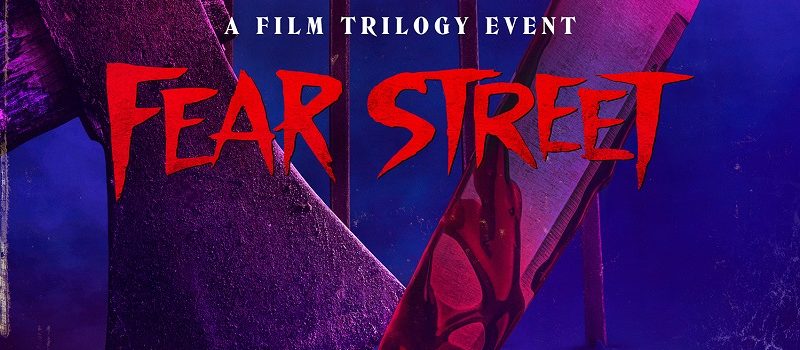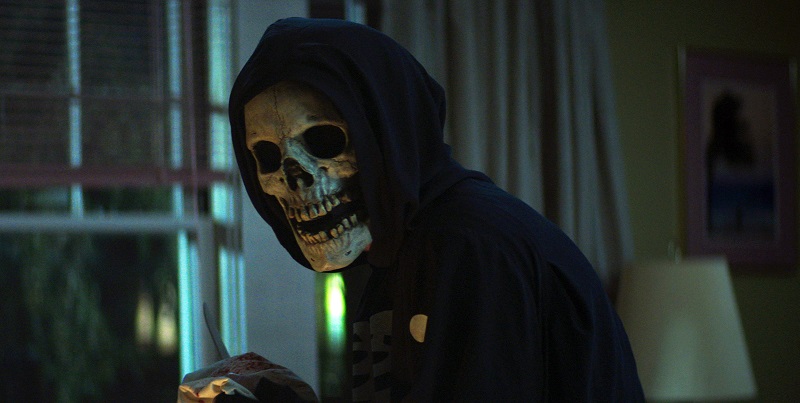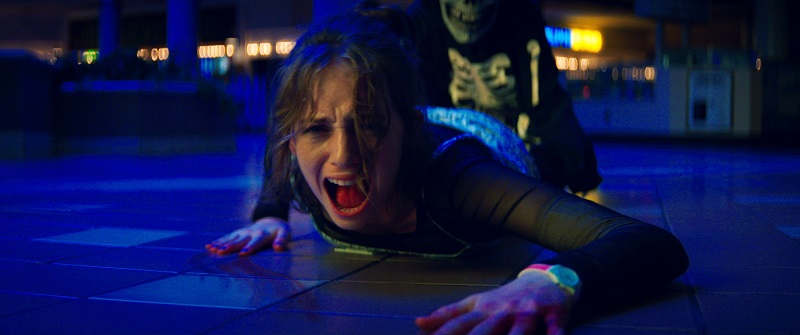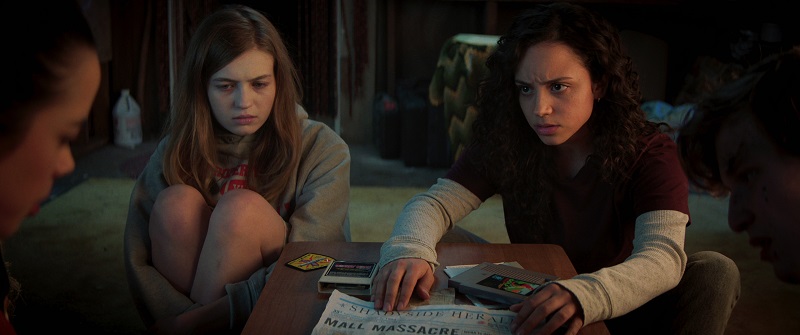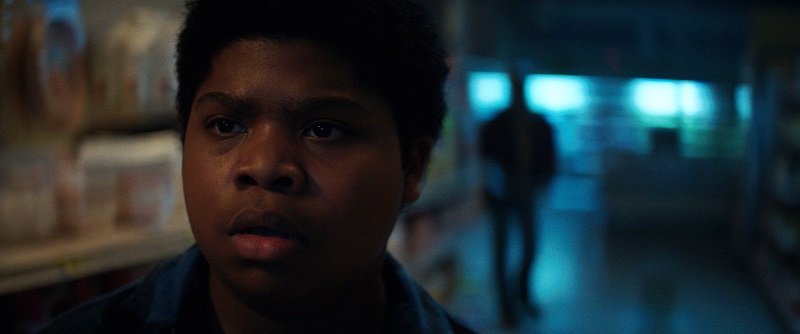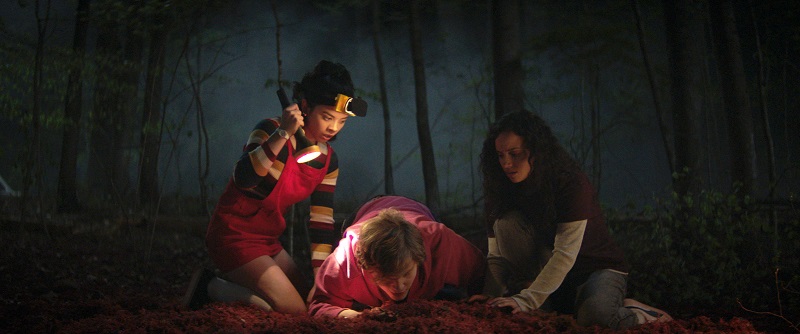The pages of author R.L. Stine (Goosebumps) got a bit scarier for his readership that was growing up with him when he first released the Fear Street series in 1989. The New Girl was the title, and it was just the beginning of a love affair between fans and the prolific author’s latest. Netflix has taken this series and given audiences a three-part affair that finds it in a different timeline with each entry. First, we visit 1994, then 1978, and finally 1666—where presumably this whole thing started.
One can immediately tell that the film series is based on books, given the richness of the characters and the situations they find themselves in, fighting for their lives and simultaneously trying to single-handedly solve this deadly mystery. The Fear Street trilogy is an ingenious idea and had us glued every second of the way. Director Leigh Janiak has the Midas touch with these films, and she handles the massive and epic far-reaching arc of this tale with panache and perfection. Not surprising, given that she was a director on the Scream TV show.
To call Fear Street this generation’s “Scream” is grasping for low-hanging fruit. This is in a league all by itself and of course, there will be winks to horror classics that came from the past. They are tropes for a reason! But the originality of the Fear Street trilogy in its character circles is what makes this horror trifecta truly terrific.
Fear Street 1994
What begins as a neon sign bright salute to the Scream franchise—thank you Maya Hawke—Fear Street 1994 quickly becomes its own entity. Cast with a group of young people that could pass for you or me at that age, they collectively bond over a supposed witchy curse set in motion hundreds of years ago. A slasher has killed a handful of people at the mall (including Hawke’s Heather) and he is none other than a friend of Heather and a supposedly normal mall employee. The killer is dressed in a skeleton costume and when police shoot him in the act of another slashing, Shadyside believes this latest chapter of horror for their town is over. Guess again.
Teens Deena (Kiana Madeira) and her kid brother Josh (Benjamin Flores Jr.) basically run their house as their absent father is almost always drunk. The day after the massacre at the mall, Deena looks out the window as she’s getting ready to join her marching band for “the big game” against rival town Sunnyside, she sees a man in a skeleton costume with a knife at his side. Panicked she races to her friend’s house Kate (Julie Rehwald), where their pal Simon (Fred Hechinger) is also hanging out. They figure Deena is just a little rattled and head to the game.
That’s where things start snowballing, the bodies start piling up and Deena and her pals are determined to find the true reason behind the killings that stem from hundreds of years prior with a witch’s curse that has hung over the city for ions. After all, how is a killer shot in the head still walking around killing?
Fear Street 1994 sets up the entire series brilliantly. We hear just enough about this witch’s curse and the history of Shadyside to believably believe that residents of this hamlet believe they are cursed because of a witch that before being hung, took off her own hand on “The Devil’s Stone.” Thus, allowing her to haunt forever. Fiercely determined to not be the next victim or victims of this killer, the teens embark on a simultaneous civic history lesson of their town all while avoiding a slasher that just won’t die. Skeleton suit guy… he’s not alone. There are a few other killers on the loose from the past who are suddenly back-to-life in the town that our heroes have to avoid while trying to solve this mystery.
The casting is top-notch. These are not simply actors to fill a part in a trilogy, they are very much integral to the entire three-movie set. Each one is connected to the previous and it’s a fascinating entity that is Fear Street. The first film ends on a cliffhanger, but instead of going forward with a sequel like most horror institutions, time goes in reverse and it’s time to head to Camp Nightwing in 1978.
What sets 1994 apart is the attention to detail. The production designer and the music supervisor have done an impeccable job of recapturing the early days of the internet and a life where cell phones are not proliferating the culture. A horror story is much easier to tell if there is no quick way to seek help, a la a phone in your pocket. The soundtrack is stellar and includes hits from a bevy of acts from that day that do much more than set the mod for 1994. Using popular songs costs a lot of cash, and what’s fascinating is how director Janiak utilizes these songs deserves major kudos. Too often, songs of an era are used as a crutch to tell the audience, “OK everyone, this is 1994.” Here, we get 45 to 60 seconds of the song at most before our attention is taken to something much more nefarious and the score kicks in and the fear factor goes ever higher.
Fear Street 1978
A classic nod to the Friday the 13th franchise and other sleepaway camp horror milieus, Fear Street 1978 takes us back in time from 1994 to meet Ziggy Berman (Stranger Things’ Sadie Sink) and her older sister—the suddenly preppy and aspirational Cindy Berman (Emily Rudd). Ziggy is a final year camper and her sister is a counselor at Camp Nightwing where both rival communities are divided into separate parts of the camp. Cindy has a boyfriend in Tommy Slater (McCabe Slye), who is a typical teenage guy who has one thing on his mind and it’s not keeping campers in line.
Suddenly, on the night of the big “color wars,” a vast game night that pits Sunnyside versus their bitter rivals in Shadyside, a killer starts his rampage. See, everything is peachy in Sunnyside and their history has been littered with success where Shadyside has had death, destruction, and horrors littered throughout its history. In a surprise to no one, the Sunnyside campers and counselors blame the Shadyside curse and even though they are in the middle of capture the flag, the counselors from both sides of the camp go on a frantic hunt for campers and counselors before the ax-wielding maniac strikes again and again and again.
Sink is outstanding. There is an urgency to her performance that adds layers to the tension and terror. She’s fantastic in Stranger Things, but her work in Fear Street 1978 is on a whole different level. Ziggy is caught between her sister who is dressing differently and trying to be less Shadyside than aspiring to be Sunnyside. One thing is clear: sisterhood doesn’t care which side of the border you aspire to live on when there is a killer on the loose and worse still—it is probably someone they know extremely well.
Here, the cast is up for continuing the Fear Street momentum that started with a bang in 1994. This is very much a camp of the 70s. I attended camp for years during this period and it was as if I was looking directly into my past. Again, production design and sound supervisor positions outdid themselves. This feels every bit of 1978 as the photos in any of our photo albums from back in the day. Murder, heck, even the threat of murder, hangs over this camp like an anvil.
Janiak effortlessly changes decades and never once loses the tone and tenor of the trilogy. The thing is, the second installment might not be as compelling as the first, but not by much. Also, it is important to hold judgment on the second chapter with situations like this until the third chapter has closed. On numerous occasions, the third part of a trilogy makes the second better and that is certainly the case here with the debut of Fear Street: 1666, which takes us back to the beginning to reveal that all is not what it seems in the Shadyside and Sunnyside rivalry that goes back centuries.
The horror in the second installment is real, raw, and given that it is centered in the woodsy area of a camp, the fear factor increases. This freight train of horror is steamrolling towards something and whatever it is, we are here for it. By the time 1978 closes, we are more than ready to head back to the beginning, 1666 where this witches’ curse began its lifelong terror on a community.
Fear Street 1666
As Fear Street: 1978 closes, it provides a direct link to Fear Street: 1666—which is out now! All three are on Netflix for your thrils!
Our 1994 crew keenly knows the secret to break the curse lies in the past, but how? Immediately, Janiak takes us back to a settlement in Massachusetts where a community is tight but is ever fearful of what lies beyond the woods and the evil within man and woman.
Madeira is congruent throughout all these episodes and she takes the persona of the “witch” that is perceived to be responsible for all the horrors in Shadyside’s past. The actress is Sarah Fier, and she plays Sam Fraser in 1994 and Olivia Scott Welch is Hannah Miller. It’s the 17th century and one thing is for certain—relations between people of the same sex are not only not tolerated, but borderlines on the work of the devil. Fier and Miller have something special that is clear from 1994 and is ever-present in 1666 and it is that love that drives the entire trilogy.
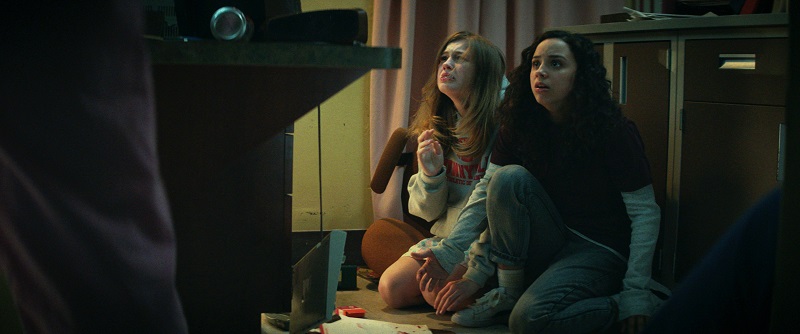
Rarely, a horror trilogy with such mythology of horror tropes of the past would boil down to a love story, but that is exactly what Fear Street is and due to that fact, it resonates immensely. The actresses sell it, and it can be seen as a tragedy, but we prefer to think of it in the realm of Romeo and Juliet—a love story that transcends the ages.
There’s something fascinating about stories that take place upon the first settling of America. The fear was real and raw. This is a people in a strange land where even the crack of a branch breaking is enough to send shivers through one’s spine. The belief that witches were doing the devil’s work is ever-present and all over the entire trilogy. What else is abundantly clear is that Fear Street is a lesson in love and acceptance—something that hasn’t happened for centuries and honestly, is still something we are working out.
Overall Trilogy Collective Thoughts:
Horror audiences are a wise bunch. They have seen it all. Camp massacres, check. Masked killers wreaking havoc with teens, check. Witchcraft tales spun from the days of early Massachusetts settlements, check. Yet with Fear Street, it all goes into a gigantic pot of gumbo that is simmering over hours and hours until its final moments reveal a taste for the terror that is both fiery and fierce. Again, it is clear that Fear Street is based on a book series. Only a literary work possesses the richness that permeates across characters, locales, and time periods.
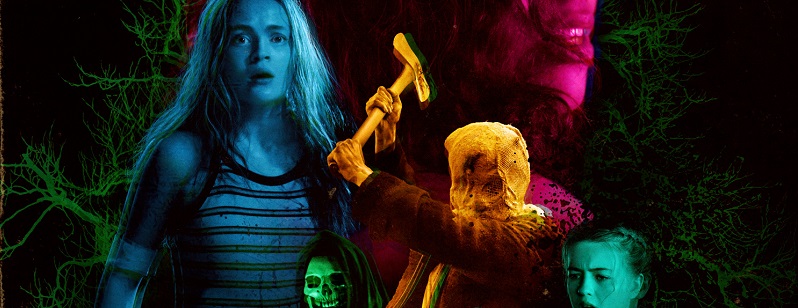
Now that I have seen all three on separate occasions it is with supreme joy that I look forward to witnessing all three in a row and buckle up for one hell of a ride.
Grade: A

